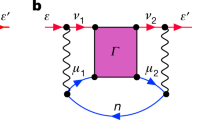Abstract
The theories regarding the formation of positronium in molecular substances are discussed. A modified theory based upon the “spur” theory is described. Theoretical derivation and experimental results suggest that the fraction of the long lifetime component due too-positronium annihilation has a complex origin. Initially, the electron of the positron-electron pair is likely to be separated from the positron by medium molecules even when the total kinetic energy of the pair is less than the potential energy between them. The formation of positronium depends on the mobilities of the positron and electron, the slowing down process and the potential energy between them. Positronium is formed in less than 10 ps. Then the positronium produced may react with the radicals created in the “spur” due to the positron. Only the fraction ofo-positronium able to escape the “spur” will have a long lifetime. Therefore, positronium formation is highly related to the fast reactions in the “spur” during the first 100 ps.
Similar content being viewed by others
References
J.W.Shearer, M.Deutsch: Phys. Rev.76, 462 (1949)
M.Deutsch: Phys. Rev.82, 455 (1951)
M.Deutsch: Phys. Rev.83, 866 (1951)
A.E.Ruark: Phys. Rev.68, 278 (1945)
For example: Y.Ito, Y.Tabuta: Radioisotopes31, 312 (1972); J.A.Merrigan, J.H.Green, S.J.Tao:Physical Methods of Chemistry, ed. by A. Weissberger and B.W. Rossiter (Wiley, New York 1972) Vol. 1, Pt IID; H.J. Ache: Angew. Chem.85, 234 (1972); Bela Levay: Kem. Kozlem.27, 221 (1972); Ref [10] and [18], and others
S.J.Tao: J. Chem. Phys.46, 5499 (1972)
S.J.Tao: Appl. Phys.2, 1 (1974)
B.Levay, A.Vertes, P.Hautojarvi: J. Phys. Chem.77, 2229 (1973)
R.E.Green, R.E.Bell: Can. J. Phys.26, 1684 (1958)
V.I.Goldanski: Atomic Energy Review6, 3 (1968)
T.L.Williams, H.J.Ache: J. Chem. Phys.50, 4493 (1969)
P.G.Varlashkin: J. Chem. Phys.61, 1257 (1974)
S.Y.Chuang, S.J.Tao: Phys. Rev. A9, 989 (1974)
S.Y.Chuang, S.J.Tao: Appl. Phys.3, 199 (1974)
A. Ore: Univ. i Bergen Arbok. Naturvitenskap, Rekke, No. 12 (1949)
Please refer to review articles such as the ones listed under [5]
O.E.Mogensen: J. Chem. Phys.60, 998 (1974)
J.Lee, J.H.Green:Positronium Chemistry (Academic Press, New York 1964)
The reader is referred to many review articles, e.g., the ones appearing in many volumes of The Annual Review of Physical Chemistry
P.R.Gray, C.F.Cook, G.P.Sturm, J. Chem. Phys.48, 1145 (1968)
Floyd Buckley, Arthur A.Mayott: NBS circular 589 (1958)
R. C. Miller, D. E. Williams, Digest of the Literature on Dielectrics,18, 22 (1954), NRC Publication 383; A.J.Petro, D.A.Pitt:20, 30 (1956), NRC Publication 562
M.Anbar, E.J.Hart: J. Am. Chem. Soc.86, 5633 (1964)
E.J.Hart, S.Gordon, J.K.Thomas: J. Phys. Chem.68, 1271 (1964)
J.K.Thomas, S.Gordon, E.J.Hart: J. Phys. Chem.68, 1524 (1964)
S.Gordon, E.J.Hart, M.S.Matheson, J.Rabani, J.K.Thomas: J. Am. Chem. Soc.85, 1376 (1963)
J.H.Baxendale, E.M.Fielden et al: Nature201, 468 (1964)
J.H.Ormrod, B.G.Hogg: J. Chem. Phys.34, 624 (1961)
S.J.Tao, T.M.Kelly, S.Y.Chuang, J.M.Wilkenfeld: Appl. Phys.3, 31 (1974)
S.J.Tao: J. Chem. Phys.52, 752 (1970)
S.J.Tao, J.H.Green: J. Phys. Chem.73, 882 (1969)
L.J.Lawrence, J.Bartel, Hans J.Ache: Radiochem. Acta19, 49 (1973)
Private communication
S.J.Tao, J.H.Green: J. Chem. Soc. (London) 408 (1968)
L.J.Bartel, J.B.Nicholas, H.J.Ache: J. Phys. Chem.76, 1124 (1972)
L.J.Bartel, H.J.Ache: Radiochem. Acta17, 205 (1972)
T.L.Cottrell:The Strengths of Chemical Bonds (Butterworth, London 1958)
S.J.Tao: Phys. Rev. Lett.14, 935 (1965)
N.A.Lange:Handbook of Chemistry (McGraw-Hill, New York 1967)
S.Y.Chuang, B.G.Hogg, D.P.Kerr, D.M.Miller: Can. J. Phys.50, 820 (1973)
S.Y. Chuang, S.J.Tao: to published
For example: S.J.Tao, J.H.Green: Proc. Phys. Soc. (London)85, 463 (1965);
W.Brandt, I.Spirn: Phys. Rev.142, 231 (1966)
Author information
Authors and Affiliations
Rights and permissions
About this article
Cite this article
Tao, S.J. The formation of positronium in molecular substances. Appl. Phys. 10, 67–79 (1976). https://doi.org/10.1007/BF00929530
Received:
Accepted:
Issue Date:
DOI: https://doi.org/10.1007/BF00929530




